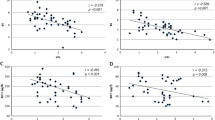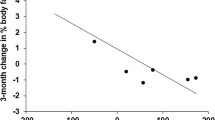Abstract
Purpose
The effect of growth hormone (GH) on adipose tissue and the role of adipokines in modulating metabolism are documented, but with discordant data. Our aim was to evaluate the impact of GH treatment on a series of selected adipokines known to have a metabolic role and poorly investigated in this setting.
Methods
This is a prospective study. Thirty-one prepubertal children (25 M, 6 F; aged 8.5 ± 1.6 years) with isolated GH deficiency treated with GH for at least 12 months and 30 matched controls were evaluated. Auxological and metabolic parameters, insulin sensitivity indexes, leptin, soluble leptin receptor, adiponectin, visfatin, resistin, omentin, adipocyte fatty acid-binding protein and retinol-binding protein-4 were evaluated before and after 12 months of treatment.
Results
At baseline, no significant difference in metabolic parameters was found between GHD children and controls, except for higher LDL cholesterol (p = 0.004) in the first group. At multivariate analysis, LDL cholesterol was independently associated with resistin (B 0.531; p = 0.002), while IGF-I was the only variable independently associated with visfatin (B 0.688; p < 0.001). After 12 months, a significant increase in fasting insulin (p = 0.008), Homa-IR (p = 0.007) and visfatin (p < 0.001) was found, with a concomitant decrease in LDL cholesterol (p = 0.015), QUICKI (p = 0.001), ISI Matsuda (p = 0.006), leptin (p = 0.015) and omentin (p = 0.003)]. At multivariate analysis, BMI was the only variable independently associated with leptin (B 0.485; p = 0.040).
Conclusions
GH treatment modifies adipokine secretion and the perturbation of some adipokine levels could contribute to the clinical and metabolic changes observed during the follow-up.

Similar content being viewed by others
References
Vijayakumar A, Novosyadlyy R, Wu Y, Yakar S et al (2010) Biological effects of growth hormone on carbohydrate and lipid metabolism. Growth Horm IGF Res 20(1):1–7
Cantley J (2014) The control of insulin secretion by adipokines: current evidence for adipocyte-beta cell endocrine signalling in metabolic homeostasis. Mamm Genome 2:442–454
Capalbo D, Esposito A, Di Mase R et al (2012) Update on early cardiovascular and metabolic risk factors in children and adolescents affected with growth hormone deficiency. Minerva Endocrinol 37:379–389
Salerno M, Esposito V, Farina V et al (2006) Improvement of cardiac performance and cardiovascular risk factors in children with GH deficiency after 2 years of GH replacement therapy: an observational, open, prospective, case-control study. J Clin Endocrinol Metab 91:1288–1295
van der Sluis IM, Boot AM, Hop WC et al (2002) Long-term effects of growth hormone therapy on bone mineral density, body composition, and serum lipid levels in growth hormone deficient children: a 6-year follow-up study. Horm Res 58:207–214
Nørrelund H, Gravholt CH, Englaro P et al (1998) Increased levels but preserved diurnal variation of serum leptin in GH-deficient patients: lack of impact of different modes of GH administration. Eur J Endocrinol 138:644–652
Elimam A, Lindgren AC, Norgren S et al (1999) Growth hormone treatment downregulates serum leptin levels in children independent of changes in body mass index. Horm Res 52:66–72
Gill MS, Toogood AA, Jones J et al (1999) Serum leptin response to the acute and chronic administration of growth hormone (GH) to elderly subjects with GH deficiency. J Clin Endocrinol Metab 84:1288–1295
Edén Engström B, Burman P, Holdstock C et al (2003) Effects of growth hormone (GH) on ghrelin, leptin, and adiponectin in GH-deficient patients. J Clin Endocrinol Metab 88:5193–5198
Hana V, Silha JV, Justova V et al (2004) The effects of GH replacement in adult GH-deficient patients: changes in body composition without concomitant changes in the adipokines and insulin resistance. Clin Endocrinol (Oxf) 60:442–450
Ciresi A, Amato MC, Criscimanna A et al (2007) Metabolic parameters and adipokine profile during GH replacement therapy in children with GH deficiency. Eur J Endocrinol 156:353–360
López-Siguero JP, López-Canti LF, Espino R et al (2011) Effect of recombinant growth hormone on leptin, adiponectin, resistin, interleukin-6, tumor necrosis factor-α and ghrelin levels in growth hormone-deficient children. J Endocrinol Invest 34:300–306
Growth Hormone Research Society (2000) Consensus guidelines for the diagnosis and treatment of growth hormone (GH) deficiency in childhood and adolescence: summary statement of the GH Research Society. J Clin Endocrinol Metab 85:3990–3993
Greulich W, Pyle S (1959) Radiographic atlas of skeletal development of the hand and wrist, 2nd edn. Stanford University Press, Stanford
Matthews DR, Hosker JP, Rudenski AS et al (1985) Homeostasis model assessment: insulin resistance and beta-cell function from fasting plasma glucose and insulin concentrations in man. Diabetologia 28:412–419
Katz A, Nambi SS, Mather K et al (2000) Quantitative insulin sensitivity check index: a simple, accurate method for assessing insulin sensitivity in humans. J Clin Endocrinol Metab 85:2402–2410
Matsuda M, DeFronzo RA (1999) Insulin sensitivity indices obtained from oral glucose tolerance testing: comparison with the euglycemic insulin clamp. Diabetes Care 22:1462–1470
Shuldiner AR, Yang R, Gong DW (2001) Resistin, obesity and insulin resistance–the emerging role of the adipocyte as an endocrine organ. N Engl J Med 345:1345–1346
Meazza C, Elsedfy HH, Pagani S et al (2014) Metabolic parameters and adipokine profile in growth hormone deficient (GHD) children before and after 12-month GH treatment. Horm Metab Res 46:219–223
Svensson J, Herlitz H, Lundberg PA et al (2005) Adiponectin, leptin, and erythrocyte sodium/lithium countertransport activity, but not resistin, are related to glucose metabolism in growth hormone-deficient adults. J Clin Endocrinol Metab 90:2290–2296
Nozue H, Kamoda T, Matsui A (2007) Serum resistin concentrations in growth hormone-deficient children during growth hormone replacement therapy. Metabolism 56:1514–1517
Ciresi A, Amato MC, Giordano C (2015) Reduction in insulin sensitivity and inadequate β-cell capacity to counteract the increase in insulin resistance in children with idiopathic growth hormone deficiency during 12 months of growth hormone treatment. J Endocrinol Invest 38:351–359
Heptulla RA, Boulware SD, Caprio S et al (1997) Decreased insulin sensitivity and compensatory hyperinsulinemia after hormone treatment in children with short stature. J Clin Endocrinol Metab 82:3234–3238
Rauch F, Westermann F, Englaro P et al (1998) Serum leptin is suppressed by growth hormone therapy in growth hormone-deficient children. Horm Res 50:18–21
Fukuhara A, Matsuda M, Nishizawa M et al (2005) Visfatin: a protein secreted by visceral fat that mimics the effects of insulin. Science 307:426–430
Petelin A, Bizjak M, Černelič-Bizjak M et al (2014) Low-grade inflammation in overweight and obese adults is affected by weight loss program. J Endocrinol Invest 37(8):745–755
Li ZP, Zhang M, Gao J et al (2014) Study of the correlation between growth hormone deficiency and serum leptin, adiponectin, and visfatin levels in adults. Genet Mol Res 13:4050–4056
Ciresi A, Amato MC, Pizzolanti G et al (2015) Serum visfatin levels in acromegaly: correlation with disease activity and metabolic alterations. Growth Horm IGF Res 25:240–246
Kralisch S, Fasshauer M (2013) Adipocyte fatty acid binding protein: a novel adipokine involved in the pathogenesis of metabolic and vascular disease? Diabetologia 56(1):10–21
Graham TE, Yang Q, Blüher M et al (2006) Retinol-binding protein 4 and insulin resistance in lean, obese, and diabetic subjects. N Engl J Med 354:2552–2563
von Eynatten M, Humpert PM (2008) Retinol-binding protein-4 in experimental and clinical metabolic disease. Expert Rev Mol Diagn 8:289–299
Lanes R, Soros A, Gunczler P et al (2006) Growth hormone deficiency, low levels of adiponectin, and unfavorable plasma lipid and lipoproteins. J Pediatr 149:324–329
Jaikanth C, Gurumurthy P, Cherian KM et al (2013) Emergence of omentin as a pleiotropic adipocytokine. Exp Clin Endocrinol Diabetes 121:377–383
Li XP, Zeng S, Wang M et al (2014) Relationships between serum omentin-1, body fat mass and bone mineral density in healthy Chinese male adults in Changsha area. J Endocrinol Invest 37(10):991–1000
Acknowledgments
This research did not receive any specific grant from any funding agency in the public, commercial or not-for-profit sector.
Author information
Authors and Affiliations
Corresponding author
Ethics declarations
Conflict of interest
All authors declare that there is no conflict of interest that could be perceived as prejudicing the impartiality of the research reported.
Ethical approval
All procedures performed were in accordance with the ethical standards of the institutional and/or national research committee and with the 1964 Helsinki declaration and its later amendments or comparable ethical standards.
Informed consent
Informed consent for the scientific use of the data was obtained from both the participants included in the study and their parents.
Rights and permissions
About this article
Cite this article
Ciresi, A., Pizzolanti, G., Leotta, M. et al. Resistin, visfatin, leptin and omentin are differently related to hormonal and metabolic parameters in growth hormone-deficient children. J Endocrinol Invest 39, 1023–1030 (2016). https://doi.org/10.1007/s40618-016-0475-z
Received:
Accepted:
Published:
Issue Date:
DOI: https://doi.org/10.1007/s40618-016-0475-z




